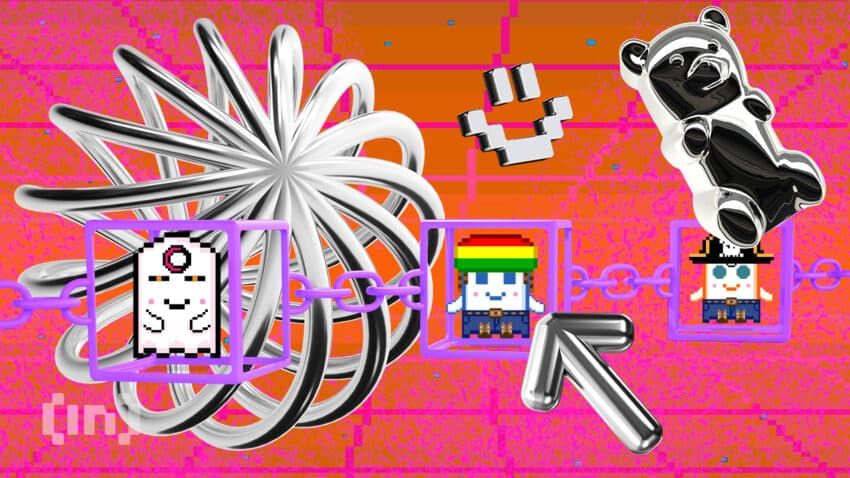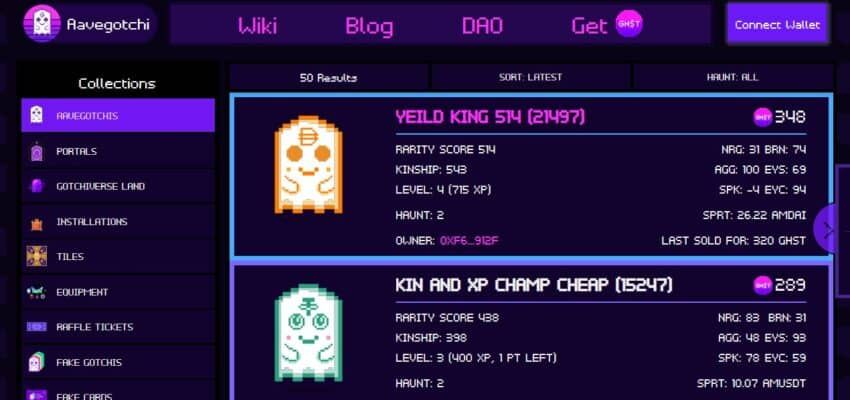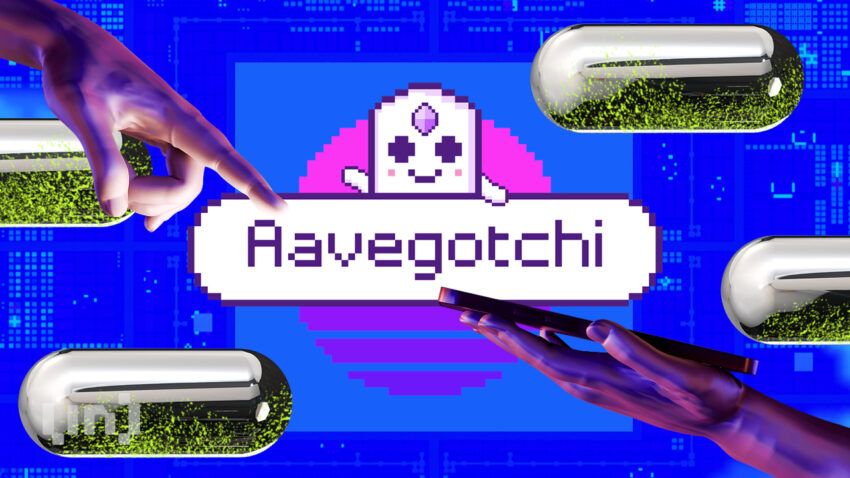NFTs and play-to-earn mechanics have revolutionized the world of gaming. By allowing players to own their in-game assets, blockchain gaming has provided people with a secondary source of income. While most of these games still primarily offer entertainment value, Aavegotchi focuses equally on the financial aspects.
Aavegotchi functions as a unique P2E game, with its main focus being a DeFi protocol for staking and NFTs. This Aavegotchi guide dives into the immersive world of value-backed playable assets. Let’s explore the world of Gotchi ghosts and dive into this innovative project in more detail.
What is Aavegotchi?

Aavegotchi is a play-to-earn (P2E) NFT farming multiple-multi-player-online RPG built on the Polygon blockchain. The game is compatible with all web browsers and utilizes the GHST cryptocurrency token. Developed by Pixelcraft studios, Aavegotchi merges the world of NFTs with a decentralized finance (DeFi) protocol. This allows players to stake their tokens within the system.
The game’s main characters — Aavegotchis — serve as the players’ entry tickets to the game. Clearly, the game takes inspiration from the renowned handheld pet game Tamagotchi. Each Gotchi avatar is a digital collectible defined by a rarity score and determined by its attributes. Players farm tokens, purchase lands, and battle Lickquidators all while earning money in the Gotchiverse realm.
Gameplay
Players need GHST tokens to purchase an Aavegotchi directly or to purchase a Portal (pack of 10 Gotchis where you only choose one). First, players must connect their wallet to the Polygon blockchains and swap MATIC for GHST tokens. Next, they must head to the Aavegotchi bazaar and purchase an Aavegotchi.
Gotchis
Pixelated ghosts, called Gotchis, serve as the game’s digital pets. In the game, Gotchis are also yield-generating NFTs, classified by their rarity. Further, the attributes each avatar possesses determine the score. These include character traits, Spirit Force, digital wearables attached to the avatar, and kinship.
The kinship score simply represents the interaction between the player and their Aavegotchi. Aavegotchis can be staked with ERC-20 tokens powered by Aave. These are referred to as aTokens.

Let’s go over the attributes that give Gotchis their value:
- Traits – Traits affect game performance and wildly contribute to the rarity of the Aavegotchi. They can be either randomly generated, depend on player/Aavegotchi interaction, or defined by the community. Some traits include eye shape, brain size, eye color, spookiness, aggressiveness, and energy.
- Spirit Force – The Spirit Force represents the number of aTokens staked to an avatar, and it generates yield through Aave’s lending protocol. When a Gotchi is transferred to a new owner, the Spirit Force also goes.
- Wearables – Aavegotchis can be equipped with digital wearables such as swords or Bob Marley shirts which boost traits and rarity scores. Moreover, these wearables can be bought, sold, and traded in the Marketplace.
- Kinship – An Aavegotchi’s loyalty feeling is represented as kinship and starts at a fixed value which increases or decreases over time. Neglecting your avatar for a period of time will lower its kinship, for example. Finally, a high kinship level will power the user’s game performance. Consequently, players must ensure they give their avatar attention and pet it every 12 hours.
Gotchiverse realm
The Gotchiverse is the digital universe where the Aavegotchis live and operate. Included in this landscape is the Portal, which represents the gateway between the Nether and Ether realms. Portals are required when players wish to summon an Aavegotchi. They can be purchased from the Aavegotchi DApp or an external marketplace.
Moreover, each Portal contains 10 Aavegotchis with randomly-generated traits, yet a player can summon only one. However, players must stake Spirit Force to the Portal to claim their avatar or risk their Gotchi getting burned. Finally, the Mall is also included in the Gotchiverse. Here, players can purchase wearables.
AavegotchiDAO
The AavegotchiDAO is a GHST token distribution event governed by the project’s DAO (decentralized autonomous organization). Upgrades to Aavegotichis ultimately determine the rewards earned, yet the Aavegotchi community voting determines the prize distribution. The DAO will be accomplished in three phases:
- V1.0 Genesis
- V2.0 Metamorphosis
- Oasis
Token ($GHST)
GHST tokens serve as the eco-governance token that runs the Aavegotchi ecosystem. Token holders get voting power in the AavegotchiDAO. In addition, GHST is a utility within the game. Players use GHST to buy and sell items in the Aavegotchi world. The GHST price as of writing is $1.02 and ranks #345 with a market capitalization of $45,867,842. It has a circulating supply of 45,096,312 and a total supply of 46,860,476.
The token doesn’t have a max supply. Playerc can purchase an unlimited number from the Token Bonding Curve (TBC). The more GHST bought, the greater the supply. Players can sell GHST back to the TBC at any time.
Use cases
Various elements within the Gotchiverse utilize GHST to provide incentives for the holders, Aavegotchi owners, and AavegotchiDAO. For example, players buy and use GHST to summon and train Aavegotchis. Then, a portion of that total value is transferred back to the DAO to top up development funding for the game’s ecosystem. Finally, any remaining portion is distributed as token incentives to reward governance and used for rarity farming rewards.
Staking
Holders of GHST can stake their coins in the Aavegotchi Staking Contract. This will earn them a non-transferable balance of FRENS. Players can converted FRENS into Raffle Tickets. These give players a chance to win wearables. Moreover, these tickets can also be converted into Drop Tickets, where players can win virtual land or portals. Furthermore, GHST can be staked to unlock REALM tokens representing land ownership in the Aavegotchi digital world. All transactions involving wearables and REALM in the game use GHST.

Tokenomics
Three phases made up the token distribution:
- Private Round – 5,000,000 GHST @ 0.05 DAI / GHST (funds raised were allocated to Pixelcraft Studios)
- Pre-Sale Round – 500,000 GHST @ 0.1 DAI / GHST (funds used to bootstrap liquidity in the Token Bonding Curve reserve pool with a reserve ratio of 100%)
- Token Bonding Curve (TBC) Funds raised will be available for Pixelcraft Studios through a tap mechanism controlled by GHST token holders. Tokens purchased from the TBC are not subject to any lockup or vesting period and can be claimed immediately after purchasing from the Curve.
The ecosystem and team fund received GHST in the pre-sale round. The ecosystem fund comprises 1,000,000 GHST locked according to the schedule as the private and pre-sale rounds. Finally, the team fund consists of 1,000,000 GHST locked in accordance with the same schedule as just the private round.
Revenue sharing
All the GHST tokens spent on portables and wearables are subject to four different revenue-sharing mechanisms.
- Earn it – 40% of all earned GHST will be distributed back to players via player rewards.
- DAO it – 15% of revenue will initially be distributed to the DAO treasury.
- Burn it – 5% of GHST earned via item and portal sales will be burned.
- Build it – 40% of the revenue will go to the development team.
Price history
At the time of writing, the GHST price is currently up. The overall price action has seen a 57.6% drop in a year. GHST reached its peak on Nov. 25, 2021, scaling a high of $3.08, a significant jump from its all-time low of $0.48 on Dec. 1, 2020.

Where can I buy ($GHST)?
Most widely know crypto exchanges offer GHST. You can either buy from a centralized exchange (CEX) or a decentralized exchange (DEX). Some of the top platforms to buy GHST tokens include:
Centralized exchanges
Decentralized exchanges
How to earn while playing
NFT avatars and farmland parcels take centre stage in the game, with farmland equipment used to extract tokens. Players can purchase more land and upgrade their avatars to earn higher yields. However, there are other ways in which users can earn while playing. These include:
- Earn interest by owning USDC-stored Aavegotchi ghosts
- Winning NFT prizes through upgrading your Aavegotchi
- Taking care of your Gotchi by dressing it up with NFT wearables, making it rarer to receive prizes
- Participate in rarity farming
- Earn FRENS to buy raffle tickets by staking GHST
- Bidding on Aavegotchi’s bid-to-earn GBM auctions
- Trade NFTs in the Aavegotchi Baazaar, including installations, portals, land, tiles, etc.
- Provide liquidity for Alchemica on Quickswap and earn daily GLTR rewards
The land parcels
Players can purchase NFTs known as REALM, which represents parcels of land. Next, Gotchis can use REALM to farm Alchemica. Parcels are equipped with various NFT Installations or decorated with Aesthetica (aesthetic NFTs). This increases farming volume. The three sizes of land parcels include Humble, Reasonable, and Spacious.
Moreover, the game features another in-game currency; Gotchus Alchemica (GAX) includes four tokens: FUD, FOMO, ALPHA, and KEK. Users can craft installation by combining these tokens. Another token, GLTR, allows players to speed up this process and reach higher levels in the game.
A Citadel, protected by a fortress, is another feature in the Gotchiverse Realm. The realm contains a Grid, where NFT Lickquidators attack Aavegotchis to steal their Gotchus Alchemica.

Story and beginnings
Pixelcraft Studios is the company behind Aavegotchi. A robust team of NFT and DeFi heavyweights founded the project in 2020. The main personality behind Aavegotchi is Jesse Johnson. Many know him as the creator of Bullionix, the first NFT backed by gold. Alongside Johnson is his pseudonymous co-founder, Coder Dan. The core idea? For players to use Aavegotchis for collateral, which making use of P2E and NFT features. Ultimately, Aavegtochi feels like DeFi is the primary modus operandus; gaming secondary. This doesn’t indicate the game is unenjoyable. Rather, the P2E features are properly considered, instead than a novelty extra in an otherwise web2 game.
Aavegotchi and the future of GameFi
While P2E games are on the rise, Aavegotchi aims to differentiate itself from the rest of the crowd, focusing on DeFi. As for the future, the dev team plans to implement additional functionalities to the gameplay. One gameplay element in the works features an Estate that will allow players to link parcels adjacent to each other. In addition, an Aavegotchi hardware wallet, an app, more game haunts, and a Gotchi Lodge are also on the roadmap.
All of these elements will enable more opportunities to earn money while playing. As the Aavegotchi project continues its growth in both the GameFi and DeFi ecosystems, this Aavegotchi guide demonstrates one thing. We are witnessing a rapid and exciting trajectory in the blockchain gaming space. Fasten your seatbelt, gamers.
Frequently asked questions
Is Aavegotchi free to play?
Which blockchain is Aavegotchi on?
Is Aavegotchi worth playing?
Disclaimer
In line with the Trust Project guidelines, the educational content on this website is offered in good faith and for general information purposes only. BeInCrypto prioritizes providing high-quality information, taking the time to research and create informative content for readers. While partners may reward the company with commissions for placements in articles, these commissions do not influence the unbiased, honest, and helpful content creation process. Any action taken by the reader based on this information is strictly at their own risk. Please note that our Terms and Conditions, Privacy Policy, and Disclaimers have been updated.




